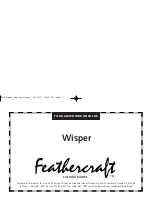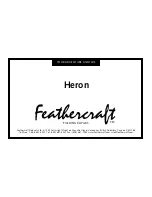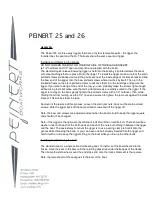
stowed in a readily accessible location. Equipment having a date
showing useful service life must be within the specified usage date
shown. Both pyrotechnic and non-pyrotechnic equipment must be
U.S. Coast Guard approved.
Pyrotechnic U.S. Coast Guard approved visual distress signals and
associated equipment include:
•
Red flares, hand held or aerial
•
Orange smoke, hand held or floating
•
Launchers for aerial red meteors or parachute flares
Non-pyrotechnic equipment includes an orange distress flag and an
S-O-S electric distress light.
No single signaling device is ideal under all conditions for all purposes.
Consider carrying various types of equipment. Careful selection and
proper stowage of visual distress equipment are very important. If
young children are frequently aboard, you should select devices with
packages which children, but not adults, will find difficult to open.
Sound Signaling Device
Your Robalo boat must have a device that can produce a sound sig-
nal when conditions require. For boats over 26 feet, the device must
be able to produce a two-second blast which can be heard a mile
away. For boats less than 26 feet, it must be able to produce a two-
second blast which can be heard one-half mile away. It can be a
hand, mouth or power operated horn or whistle. Refer to the U.S.
Coast Guard’s publication “Navigational Rules, International-Inland”
for details about the appropriate signals.
RUNNING AND NAVIGATION LIGHTS
Your boat must have running and navigation lights for safe opera-
tion after dark. Observe all navigation rules for meeting and
passing. Do not run at high speeds during night operation. Always
use common sense and good judgment.
SAFETY AFLOAT
Once your boat is launched and your excursion is underway, you
need to be aware of your surroundings and how they may affect your
safety and that of your passengers. There is no substitute for good
judgment and common sense.
Weather
Storms rarely appear without advance notice. Check the weather
forecast before you begin a day of boating. Be aware, however, that
weather conditions can change rapidly. If you have a marine radio,
listen to the weather reports issued by the U.S. Coast Guard and
others. If you have a portable radio, keep it tuned to a station broad-
casting frequent weather reports. Many boating clubs fly weather
signals. Learn to recognize these signals and listen to your local
forecasts before leaving port.
Your surroundings can also be a good indicator of changing weather
conditions. Watch for changes in wind direction or cloud formations.
There is no substitute for a good understanding of weather condi-
tions and what to do when the weather takes a turn for the worse.
Fog
Fog is a result of either warm-surface or cold-surface conditions.
You can judge the likelihood of fog formation by periodically mea-
suring the air temperature and dew point temperature. If the
difference between these two temperatures is small, fog is likely to
develop. Remember the following guidelines:
•
Turn on running lights.
•
Unless your boat is well equipped with charts, head for shore at
the first sign of fog and wait until conditions improve. If you have
charts on board, take bearings as fog sets in, mark your posi-
tion, and continue to log your course and speed.
•
Make sure all persons on board have put on their personal
floatation devices.
2-5
Summary of Contents for 2012 220
Page 18: ...1 11...
Page 23: ...1 16...
Page 75: ...4 13...
Page 112: ...11 1 WIRING SCHEMATICS 11 Robalo 220...
Page 113: ...11 2 Robalo 220...
Page 114: ...11 3 Robalo 225...
Page 115: ...11 4 Robalo 225...
Page 116: ...11 5 Robalo 227...
Page 117: ...11 6 Robalo 227...
Page 118: ...11 7 Robalo 240...
Page 119: ...11 8 Robalo 240...
Page 120: ...11 9 Robalo 245...
Page 121: ...11 10 Robalo 245...
Page 122: ...11 11 Robalo 247...
Page 123: ...11 12 Robalo 247...
Page 124: ...11 13 Robalo 260...
Page 125: ...11 14 Robalo 260...
Page 126: ...11 15 Robalo 265...
Page 127: ...11 16 Robalo 265...
Page 128: ...11 17 Robalo 300...
Page 129: ...11 18 Robalo 300...
Page 130: ...11 19 Robalo 305...
Page 131: ...11 20 Robalo 305...
Page 132: ...WIRING SCHEMATICS 12 12 1 Signature 370...
Page 133: ...12 2 Signature 370...
Page 134: ...12 3 Signature 350...
Page 135: ...12 4 Signature 350...
Page 136: ...12 5 Signature 330...
Page 137: ...12 6 Signature 330...
Page 138: ...12 7 Signature 310...
Page 139: ...12 8 Signature 310...
Page 140: ...12 9 Signature 290...
Page 141: ...12 10 Signature 290...
Page 142: ...12 11 Signature 270...
Page 143: ...12 12 Signature 270...
















































